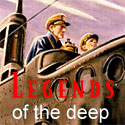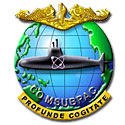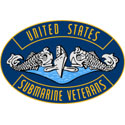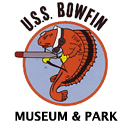Got the following recently from Dr. John Christensen regarding the wreck and how it validates or disproves the circular run torpedo theory postulated by Richard O'Kane in his book "Wahoo".
If you've read the book you are familiar with O'Kane's assertion that Wahoo was transiting La Perouse on the surface and was first attacked by shore batteries before submerging and falling victim to a coordinated air and sea attack. In order to create a scenario that would require Morton to remain on the surface in daylight, O'Kane concluded some sort of damage must have prevented him from diving. He settled upon a casualty caused by a circular run torpedo.
Before I share my response to Dr. Christensen I'd like to hear from you. What do you interpret from the wreck photos? How credible do you think O'Kane's theory is (or was)?
________________________________________
In looking at the amazing photos and drawings of USS WAHOO provided by the Russian divers, it seems to me the damage could indeed be from a circular torpedo run, not necessarily an aerial bomb.
In Commander O'Kane's account of the circular torpedo run that sank USS TANG in "Clear the Bridge", he felt it would have hit TANG amidships (at the conning tower) had he not been able to accelerate. I believe the pictures of the USS WAHOO are also consistent with an amidships hit from a torpedo on a circular run.
This would be an important interpretation of these photos regarding the cause of WAHOO's sinking, especially since there is no corresponding record of an aerial hit from the Japanese, and in view of the experience and skill of USS WAHOO's skipper and crew in avoiding such a strike.
http://www.warfish.com/scrap-EP.html. See second page, divers drawings.
Thank you.
Dr John Christensen
This Sounds Like It's From The Onion...
12 years ago








2 comments:
The possiblility of Wahoo surviving a circular run from its own torpedo is simply not feasible. A hit amidhsips would have rsulted in extreme damage to the control room, pump room, and battery compartments. The stability of the vessel would have immediately been compromised and gaining buoyancy would have been impossible. There are records that indicate the Japanese dropped aerial bombs and most likley the conclusion of the Russian divers is accurate. The Tullibee sank immediately after being hit by a circular run and the same would have occured with Wahoo. Questions regarding the feasibility of approaching La Perouse during daylight hours is debatable and perhaps Wahoo was damaged in some way, or perhaps Morton simply felt that with his sucess, coupled with the anticipated success of Sawfish, felt that a daylight passage would catch the Japanese off guard. To an extent, Wahoo's luck ran out and Lockwood's decision to re-enter La Perouse was flawed as well. The strategy was sound, but the tactics were not. There was too much risk in leaving the Sea of Japan. Anyone with access to one of the fleet boats on display, Cod in Cleveland, Silverside in Muskegon, Croaker in Buffalo, etc, can easily see that damage in the area witnessed by the Japanese would be catastrophic. The answer to the puzzle lies with Morton and the rest of Wahoo. We will never know.
I agree with Captdd.
The Wahoo would not have been able to stay afloat if she had been hit with her own torpedo.
It would be beneficial to find Tang so we could see the type of damage caused by a torpedo so we could rule out this theory.
Chuck
Post a Comment